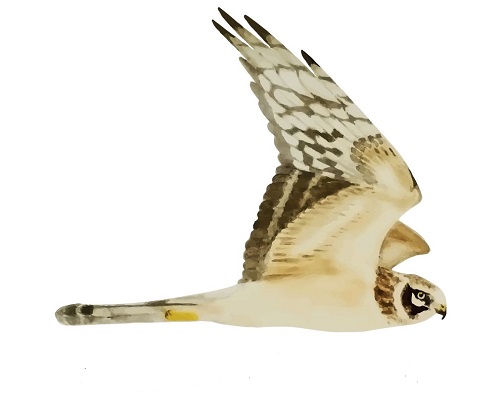Her på Skagen Fuglestations blog bringes korte nyheder i dagbogsformat om hændelser på fuglestationen.
A Day of Ducks
Today was a very windy day, so we couldn’t go ringing in the morning. Still, Migration Count was possible, so Hayley, Gustav and Simon went out. To get a little bit of shelter from the wind, they chose another location today and went to Sandorme Sporet, where they had shelter behind the dune. Apparently, there was a lot to see and it was one of the best days so far.

The most observed species today were – ducks! Teals (Krikand), Wigeons (Pibeand), Pintails (Spidsand), Common Scoters (Sortand), Velvet Scoters (Fløjlsand) and Eider ducks (Ederfugl). But other birds were there as well, for example red breasted Merganser (Toppet skallesluger), dark bellied Brent Geese (Knortegås), Red knots (Islandsk ryle), Grey Plovers (Strandhjejle) and a young black Guillemot (Tejst). Our guests, Jette and Anders, went out early as well and had some nice observations of Gannets (Sule), Dunlins (Almindelig ryle) and Great Black-backed Gulls (Svartbag).
Meanwhile, Rebecca and I could sleep a little longer, which was a much needed rest for me. We had breakfast and when the others came back we got some delicious cake from our friends of the Lighthouse crew, which was an exciting treat. All danish cakes I had so far were really good!
Despite the wind, some birding around the lighthouse was done. We could see a Sparrowhawk (Spurvehøg) and an adult Arctic tern (Havterne), which was a little late in the month and therefore nice to watch. Today Simon Sr. had guests from friends from the Norwegian Bird Observatory, the Store Færder Ornithologiske Stasjon. You can check out their new cool website on this link. It was really interesting to hear about another station, the daily life and the bird species they catch. Simon Sr. showed them the active radiotelemetry reciever which hopefully will find some of the passerines that are being equipped with radiotags in southern Norway during these days - among them Tree Pipits.
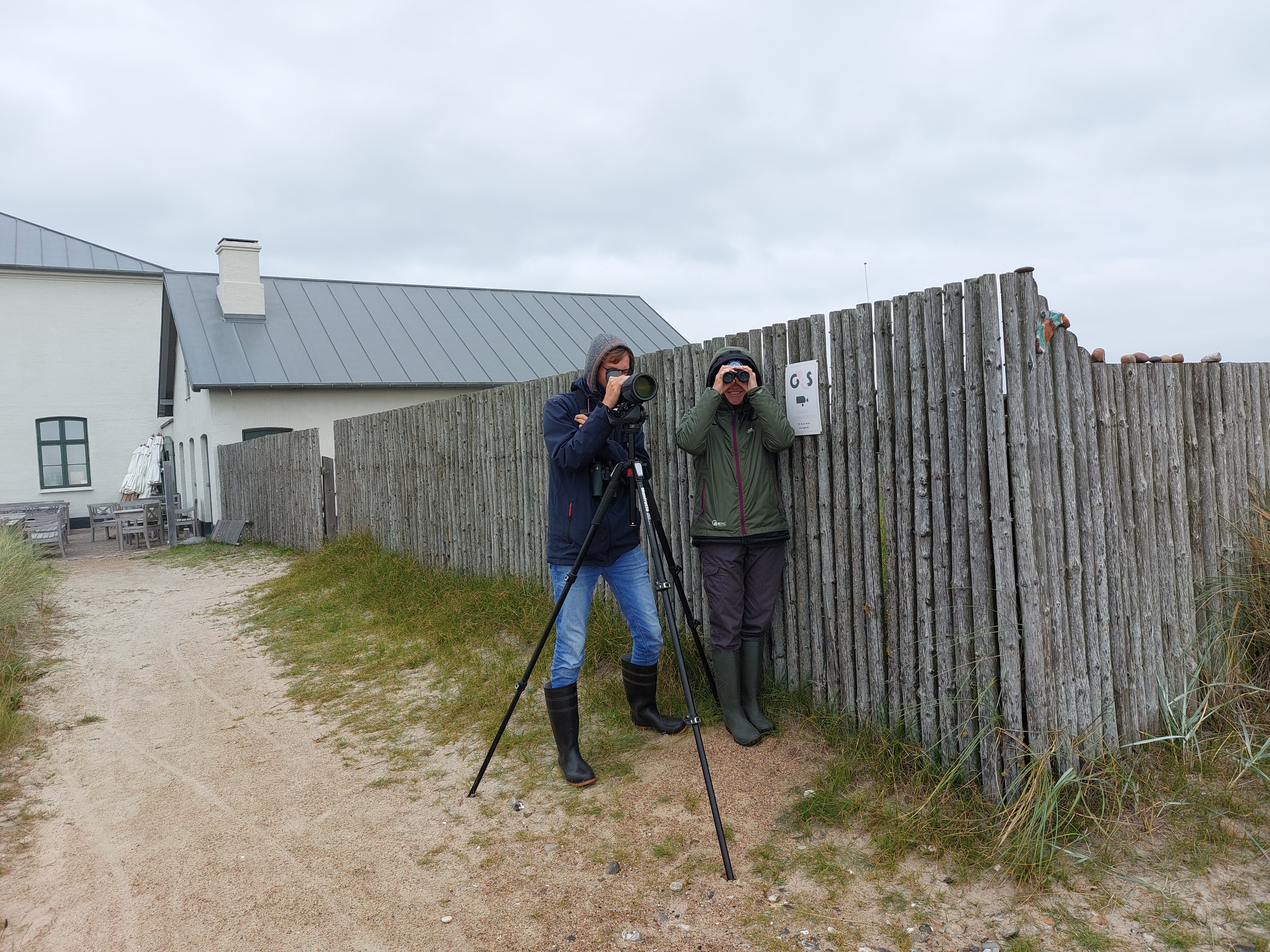
Then we did something we had never done before but was a lot of fun: we played Hide and Seek. Even though there weren’t many possibilities for four out of five volunteers to hide in the same building, we managed to play four rounds and got very creative with our hiding spots.
People: Antonia Greil, Hayley Land, Rebecca Cheape, Gustav Nyberg, Simon Kiesé, Simon S. Christiansen, Terje Axelsen (Store Færder Ornitologiske Stasjon), Jette and Anders.
A link to today's observations from volunteers and local observers.
Yellowhammers and a Common Crossbill
Gustav and Simon started their day at World’s End 3 with the migration count. It was very quiet again, but they did enjoy seeing a Fulmar (Mallemuk), a Black-throated Diver (Sortstrubet Lom) and 20 Brent Geese (Knortegås).
Meanwhile, Rebecca and I had opened the nets at Kabeltromlen. Antonia and Esben joined for the first round and we got a nice view of the rising sun which was amazingly red. Although we caught less birds than yesterday, we had some really nice species. Quality not quantity!
The highlight of the day was this stunning young male Common Crossbill (Lille Korsnæb). In the photo below you can just see the orange feathers beginning to come through and the amazing beak which we took lots of measurements of to confirm the species. Simon Jr and Gustav were also at Kabeltromlen to see it, having finished the migration count. It was the first time many of us had seen this species in the hand, so we were all very excited!

Another highlight was two young Yellowhammers (Gulspurv), another new species in the hand for Antonia and I. The colours were amazing to see up close. It was also interesting to see the tail of one of the birds, which had a very clear fault bar through all the feathers. This may have been caused by a deficiency in food when the feathers were growing.


We also caught two lovely Lesser Redpoll (Lille Gråsisken). Both were young birds. They were aged by looking at the tail feathers.

Finally, five Goldcrests (Fuglekonge) were among the other species caught today. These are the smallest birds found in Europe; the smallest individual we caught today only weighed 4.9 grams! The picture below shows a male bird, with its stunning orange head feathers. Female birds only have yellow on the head.

After such an exciting morning we enjoyed a late breakfast back at the Fuglestation. In the afternoon, data was entered, the picture archive updated, and some cleaning done. We did a little bit of birding outside the lighthouse and enjoyed seeing a Hen Harrier (Blå Kærhøg) flying in the distance and a couple of Stonechats (Sortstrubet Bynkefugl) in nearby bushes. Rebecca also went to the harbour to do the Cormorant (Skarv) count and some shopping, and we welcomed our new guests, Jette and Anders. Unfortunately, tomorrow looks too windy for ringing but we hope to see some good birds at the migration count.
Ringing (Kabeltromlekrattet)
Robin (Rødhals) – 2
Chiffchaff (Gransanger) – 4
Blackcap (Munk) – 3
Goldcrest (Fuglekonge) – 5
Tree Pipit (Skovpiber) – 1
Reed Warbler (Rørsanger) – 2
Siskin (Grønsisken) – 2
Lesser Redpoll (Lille Gråsisken) – 2
Yellowhammer (Gulspurv) – 2
Great Tit (Musvit) – 1
Common Crossbill (Lille Korsnæb) – 1
Total: 25
People: Antonia Greil, Hayley Land, Rebecca Cheape, Gustav Nyberg, Simon Kiesé, Esben Hansen, Simon S. Christiansen, Knud Pedersen, Jette and Anders.
A link to today's observations from volunteers and local observers.
Bird Bird Bird
Bird is the word - like every day. With the difference that today was the first day on which "Bird Bird Bird" from the song "Surfin Bird" by The Trashmen also applied when ringing at Kabeltromlen.
Today was the first day with a few more birds. There is still potential for improvement, but we were all very pleased with the number of birds we were able to ring today. Already in the first round things started well and together with Esben we were able to ring especially many Blackcaps (Munk) and Robins (Rødhals). While Grey Wagtail, Peregrine Falcon and some Common Crossbills flew over us, there were rather the expected species in the net and no surprises. No surprises? Nope. Because then there was still a Tree Pipit (Skovpiber). That was really fun in the sunshine.
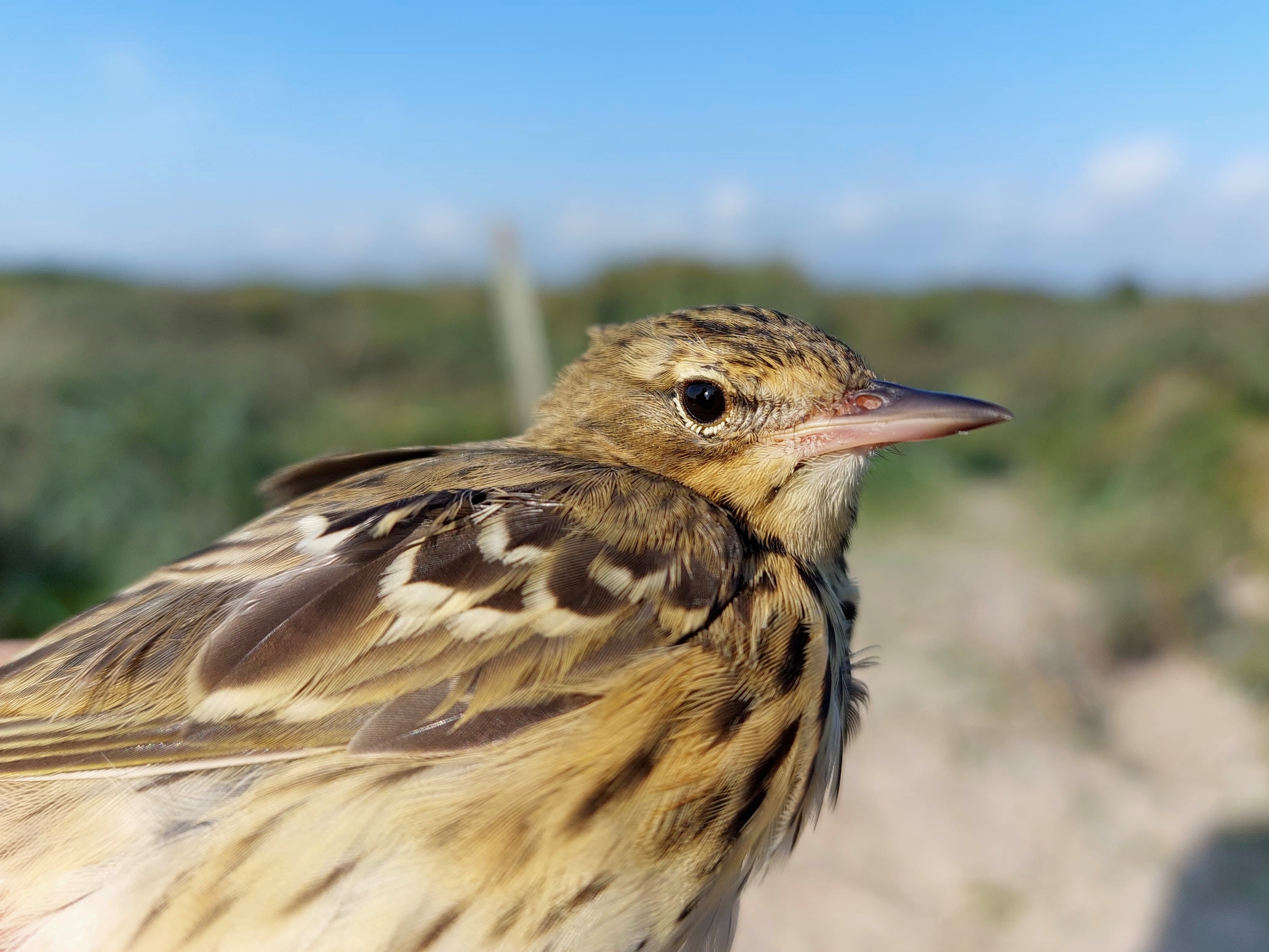
In the meantime Gustav did a guided tour for two families and came with them to see the ringing. The children seemed very interested and already knew a lot about the species. They were also kind enough to bring us an apple pie. Eating this in the sunshine while ringing was a total treat! We were also given a crocheted blackbird, which looks amazingly realistic. Thanks for that! Afterwards, Gustav took the two families to the beach to visit Knud and Rebecca.
This is the perfect segue to the migration count, isn't it? The count today was good and some birds like Goldeneye and Razorbill were seen. But perhaps the highlight was a Caspian Gull (Kaspisk Måge) resting among the many Herring Gulls and Great Black-backed Gulls. Rebecca also told us again how much she could learn from Knud. It's really good to have an experienced local from whom you can learn a lot.
At noon we left for a walk. Unfortunately we couldn't find any Adder, but still the walk in the summer sunshine was very nice! After hearing a Crestet Tit (Topmejse), we were able to see one shortly afterwards. This was Hayley's first observation of this kind. Really cool, congratulations on that. Even though the rare raptors are still missing, we could still see four Common Buzzards (Musvåge) circling up in the thermals. Afterwards Gustav left for the penultimate comrorant count to the harbour.
Ringing (Kabeltromlekrattet):
Tree Pipit (Skovpiber) - 1
Wren (Gærdesmutte) - 1
Dunnock (Jernspurv) - 1
Robin (Rødhals) - 3
Common Whitethroat (Tornsanger) - 1
Blackcap (Munk) - 20
Chiffchaff (Gransanger) - 4
Willow Warbler (Løvsanger) 1
Goldcrest (Fuglekonge) - 1
Blue Tit (Blåmejse) - 1
Reed Bunting (Rørspurv) - 1
Total: 35
People: Antonia Greil, Hayley Land, Rebecca Cheape, Gustav Nyberg, Simon Kiesé, Knud Pedersen, Esben Hansen.
A link to today's observations from volunteers and local observers.
Very windy but we got a lovely Goldcrest to brighten the morn!!
This morning was wet and a bit windy, however, me and Hayley still left the station before sunrise to open the nets at Kabeltromlen for another morning of bird ringing. Although, we were not feeling very optimistic about the number of birds we would catch in the nets as it was a bit too windy, and the birds would likely be sheltering amongst the bushes. Throughout the first two to three rounds we caught three to four birds and two recaptures, which included a juvenile Blackbird (Solsort) that was ringed two days ago by Antonia. It was interesting to re-measure this Solsort to discover that it had lost 0.2 g over two days. As the morning went on the weather deteriorated sharply as the wind became stronger blowing all the important ringing data sheets everywhere – good thing some are laminated though!
The last round was the best out of the others as we caught a beautiful female juvenile Goldcrest (Fuglekonge). I have ringed this species before back home, but it was the first one I have ringed here in Skagen so it was a nice surprise when I pulled it out of the bag. The Goldcrest is a very small bird, and I just can’t get over how such a small bird can withstand extremely bad weather and still manage to survive most of the time. It was interesting to look at the yellow head as this is how an individual can sex the bird: completely yellow = female; yellow with orange hues = male.

We decided to close the nets around 9am as the rain became very heavy and we weren’t catching any more birds. When we returned to the station, we entered the ringing data from the morning.
Whilst we were out ringing this morning, Gustav and Simon were at World’s End Three doing the migration count, however it was fairly slow, and the weather was bad so there wasn’t great visibility. Although, some species counted included one Fulmar (Mallemuk), seventy-seven Common Scoter (Sortand) and four Eurasian teal (Krikand).
As the weather was bad, we did not do the Cormorant (Skarv) count today, but we will do it tomorrow and on Sunday. The guests also left this afternoon as they are going to visit some friends and therefore had to leave two days earlier, but it was nice to meet them. Michael left after the ringing today and we all enjoyed bird ringing with him. Later in the evening, Esben will join us at the station for the next two days to bird ring with us until Simon returns next week.
The rest of the day was quiet and everyone at the station did their own thing, and Simon K. went to the supermarket to buy ingredients for tonight’s dinner.
My time here is going fast and I only have 15 days left!
Ringing (Kabeltromlekrattet):
Blackcap (Munk) - 2
Blackbird (Solsort) - 1
Chiffchaff (Gransanger) - 5
Rødstjert (Redstart) - 1
Rødhals (Robin) - 2
Musvit (Great Tit) - 1
Total = 12
People: Antonia Greil, Hayley Land, Rebecca Cheape, Gustav Nyberg, Simon Kiesé, Michael Fink, Helle and Niels.
A link to today's observations from volunteers and local observers.
To store fyre
I dag tog jeg del i ringmærkningen sammen med Simon, Hayley og Antonia. Det var dejligt forfriskende at ringmærke igen efter en længere periode med havobs. Simon og jeg tog tidligt af sted for at sætte nettene op, mens Hayley, Antonia og Michael sluttede sig til Kabeltromlen ved den første runde ud til nettene.

Første runde bød på lidt over en håndfuld fugle, heriblandt var der Gransangere, Blåmejser og Munk. Mens Simon og jeg gik og indsamlede fuglene, var der noget større og højlydt, der baskede rundt i nettet. Det var en Vandrikse! Simon spurtede af sted, men den var for hurtig for ham og fløj ud af nettet.
Anden runde bød på flere fugle, og det var her vi fik fat i to Store Flagspætter. Det er første gang jeg ser fuglen i ringmærknings regi, og det var en fed oplevelse at ringmærke sådan en smuk fugl. Larme det kan de, og det med at hakke ens fingre er de også ret gode til. I samme runde havde Simon og jeg en dejavu oplevelse, fordi der endnu en gang var en større fugl i nettet. Denne gang en Spurvehøg! Men det skulle heller ikke lykkedes denne gang selvom Simon ihærdigt prøvede at løbe i waders gennem knæhøjt vand. Selvom vi missede to eftertragtet ringmærkningsfugle var vi alle godt tilfredse med de 28 fugle vi fangede i alt samt de 5 genfangster.
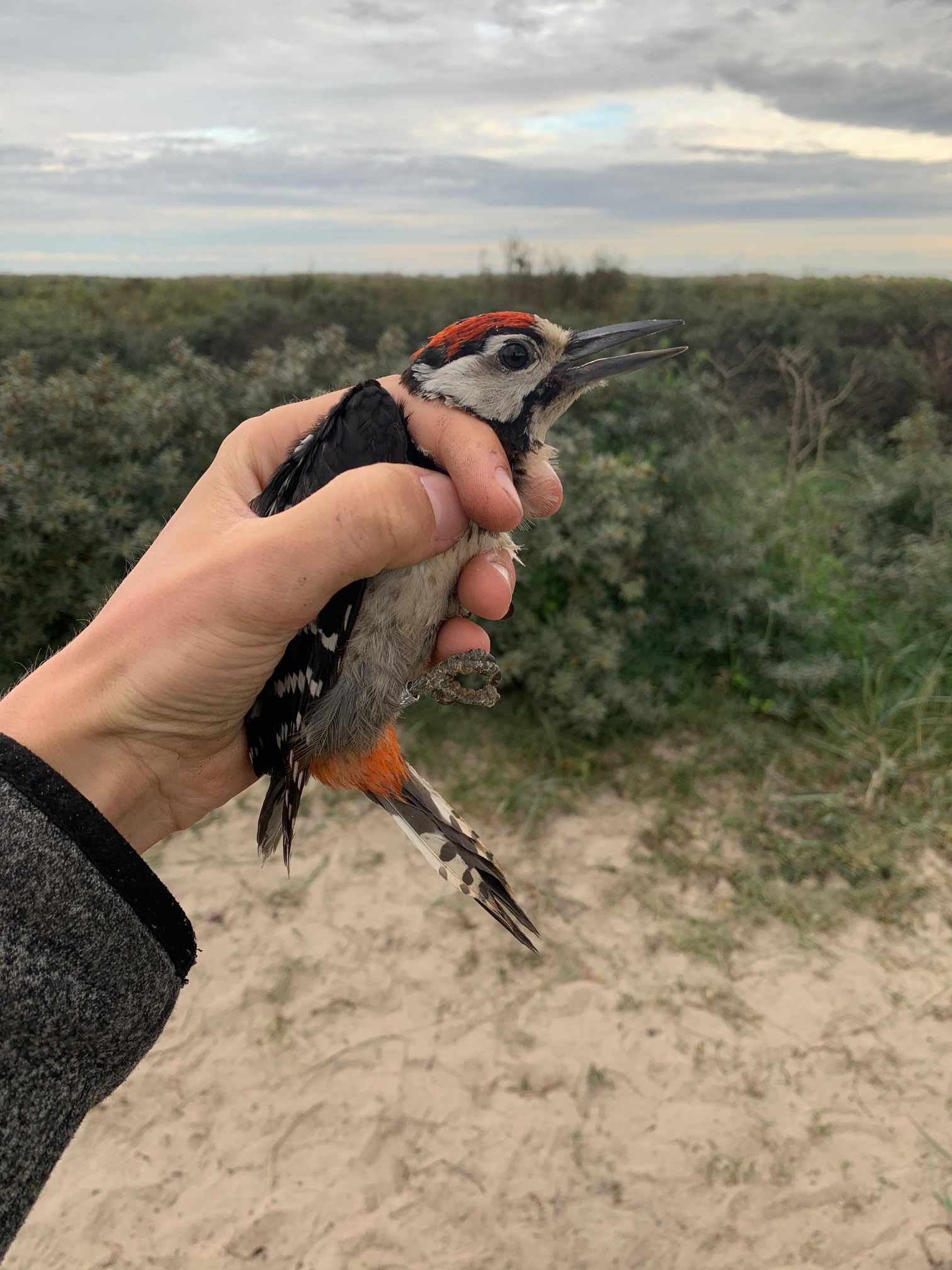
På Grenen, hvor Rebecca var denne morgen, stod det i gentagelsernes navn i form af en stille havfugle-migration. Der er endnu ikke meget gang i det store hav, men der dukkede til Rebeccas glæde Knopsvaner op fra det kolde nord.
Vores gæster Helle og Niels havde en god dag i byen og fik kigget på en masse malerier.

Ringing (Kabeltromlekrattet):
Stor Flagspætte - 2
Gærdesmutte - 4
Jernspurv - 2
Rødhals - 4
Rødstjert - 1
Tornsanger - 1
Munk - 3
Gransanger - 8
Blåmejse - 2
Rørspurv - 1
Total: 28
People: Antonia Greil, Hayley Land, Rebecca Cheape, Gustav Nyberg, Simon Kiesé, Michael Fink, Helle and Niels.
A link to today's observations from volunteers and local observers.
A Windy Day
Rebecca and Antonia opened the nets early this morning at Kabeltromlen and Michael, Simon and I joined them in time for the first round. There was a stunning sunrise as we cycled there to meet them. What a nice way to start the day!

It was a very quiet ringing day and quite windy but we still caught some nice birds. Highlights included this young Great Spotted Woodpecker (Stor Flagspætte). It was just beginning to grow red feathers on its neck showing that it is a male bird.

We also ringed a very nice young Blackbird (Solsort), a first in the hand for Antonia and the biggest bird she has ringed so far.

It was very windy morning for Gustav who did the migration count at World’s End 3. The migration was slow, particularly in the last hour. However, he had a good sighting of a Great Skua (Almindelig Kjove) which we also managed to see from Kabeltromlen. There were also some flocks of Canada Geese (Kanadagås) flying over and lots of Fulmar (Mallemuk) were also seen.
In the afternoon, Rebecca went to do the Cormorant (Skarv) count at the harbour and some shopping. Back at the fuglestation, data was inputted, nets untangled, and Antonia climbed to the top of the lighthouse for the first time. It was very windy at the top but there were great views! Later on, our apartment guests, Helle and Neils, cooked us a delicious dinner.
Ringing (Kabeltromlekrattet)
Robin (Rødhals) – 3
Blue Tit (Blåmejse) – 2
Chiffchaff (Gransanger) – 1
Blackcap (Munk) – 1
Blackbird (Solsort) – 1
Great Spotted Woodpecker (Stor Flagspætte) – 1
Total: 9
People: Antonia Greil, Hayley Land, Rebecca Cheape, Gustav Nyberg, Simon Kiesé, Michael Fink, Helle and Niels.
A link to today's observations from volunteers and local observers.
The sun comes out
After a few foggy days, we were all hoping that the sun would come out again. And today it did. When Hayley and I cycled to Kabeltromlen early in the morning to put out the nets, there were still a few raindrops in the sky. When Michael joined us it quickly got better and when Rebecca and Antonia joined us the sun came out. The birds don't seem to have had much desire to migrate last night, but at least a few Dunnocks (Jernspurv) have now arrived. All in all, it was again a great experience to carry a lot of responsibility and the ringing worked out great. Besides, we were delighted by some birds that flew overhead. Among them were two Grey Wagtails and some Common Crossbills. Then a troop of 30 Brent Goose (Knoregås) came through. Most were Pale-bellied (ssp. Hrota), but I could also spot two dark-bellied (ssp. Bernicla) at a glance. Communication with Gustav, who was now at World's End 3, worked great and so we were able to prepare him early for the incoming goose party.

Gustav also enjoyed the better weather, as there were finally a few more birds to count. For example, there were Teals (Krikand) and Wigeons (Pibeand). But when the sun became too strong, the bird migration decreased and it became boring. But then Gustav spotted two Arctic Skuas, which were just the right medicine against boredom. It quickly informed us and so we could see the birds from Kabeltromlen.
After the morning activities I deserved a shower. Afterwards Hayley and Antonia did the cormorant count at the harbour. There was not much going on and the count was boring. The AIDA ship in the harbour meant that only a few cormorants were resting. At least there were Wheatears (Stenpikker) to see. Meanwhile, Gustav went shopping and prepared dinner for the guests and us. I listened to some music and enjoyed the sun at World's End. The weather was now wonderful and I could see a Merlin (Dværgfalk) and an Arctic Skua (Almindelig Kjove).
Ringing (Kabeltromlekrattet):
Chiffchaff (Gransanger) - 6
Dunnock (Jernspurv) - 4
Common Redstart (Rødstjert) - 1
Reed Warbler (Rørsanger) - 3
Coal Tit (Sortmejse) - 1
Lesser Whitethroat (Gærdesanger) - 1
Garden Warbler (Havesanger) - 1
Blackcap (Munk) - 5
Reed Bunting (Rørspurv) - 1
Blue Tit (Blåmejse) - 1
Great Tit (Musvit) - 1
Total: 25
People: Antonia Greil, Hayley Land, Rebecca Cheape, Gustav Nyberg, Simon Kiesé, Michael Fink, Helle und Niels.
A link to today's observations from volunteers and local observers.
A common snipe to start the week right
Another ringing day, another early waking up – even though every day we get around 2 minutes more of sleep, as the sun starts rising later. Simon Jr. and I were opening the nets at Kabeltromlen today and were joined by Rebecca and Hayley for the first control walk. And we were immediately generously rewarded – a Common Snipe (Dobbeltbekkasin) was caught in the net! It was my first time seeing one up close, so you can imagine how euphoric that moment felt.

The Common Snipe (Dobbeltbekkasin)
It was a very misty and wet day, and the fog was rather thickening then lifting. Accordingly, there were fewer and fewer birds per round, and we closed the nets rather early. Still, we had a nice mix of birds, for example Bluetit (Blåmejse), Dunnock (Jernspurve), Lesser Whitethroat (Gærdesanger) and a Common Redstart (Rodjstjert). I hadn’t held a Bluetit before and quickly realized how much they like to pinch your finger – ouch. Today was the last time Henning was attending our ringing session, and tomorrow we will get to meet Michael, who will stay ringing with us for the next days.

A Dunnock (Jernspurve)
No migration count was going on today, as the view was not sufficient, but early afternoon was used for birding around the lighthouse. We saw a Rock Pipit (Skærpiber) and some Turnstones (Stenvender), and Simon Jr., who was very persistent in his observations, could watch several Arctic Skuas (Almindelig Kjove) flying across the sea and some Velvet Scoters (Fløjlsand) roosting.

The rest of the day was pure autumn weather, made of rain, wind and some more hot chocolate. Perfect weather to take some phone calls, do some writing and data stuff, and taking walks in the forest to search for mushrooms. As we call it here: Normal human stuff.
Ringing (Kabeltromlekrattet):
Common Snipe (Dobbeltbekkasin) – 1
Lesser Whitethroat (Gaerdesanger) – 1
Common Redstart (Rodjstjert) – 1
Reed Warbler (Rørsanger) – 1
Dunnock (Jernspurve) – 1
Blackcap (Munk) – 5
Bluetit (Blåmejse) – 1
Total: 11
People: Antonia Greil, Hayley Land, Rebecca Cheape, Gustav Nyberg, Simon Kiesé, Henning, Helle und Nils.
A link to today's observations from volunteers and local observers.
Stadig lidt tåget
I dag tog jeg afsted til observation, hvor der igen i dag viste sig at være lidt tåget ud over vandet. I stedet skete der lidt anderledes ting end det sædvanlige. Der var Strandtudser, der hoppede rundt ved obsposten. Det var vældig hyggeligt, det er lang tid siden jeg sidst har set denne art. Strandtudsen er en af vore mere sjældne padder, men her oppe på Grenen skulle der være en temmelig god bestand. Man kan bedst kende den på dens karakteristiske gule rygstribe. Dernæst var der en sæl, der måtte aflives. Der kom en jæger ud og skød den ved solopgang, så jeg tænker det nok har været smittet med den orme sygdom flere af sælerne heroppe bukker under for. Ellers var der en flagermus, der i dagslys fløj rundt på stranden i et godt stykke tid.


Efterhånden som tågen lettede kom der lidt gang i fuglene, men det blev ikke til det helt store. Den svage migration af fugle skulle skyldes det meget stille og rolige vejr, vi har haft den seneste uge kombineret med sydlige vinde. Senere på dagen observerede andre fuglekiggere en Sodfarvet Skråpe, der rastede ved Grenen, men den blev der desværre ikke længe.
Imens jeg var ved spidsen tog det andre til Kabeltromlen sammen med Henning. Under ringmærkning blev der ringmærket 9 forskellige arter, men Munk var klart den dominerende art i dag med hele 11 ringmærket. 22 fugle blev det til i alt, så det var en dag folk var tilfredse med. Imorgen kommer Michael, som vil erstatte Henning tirsdag morgen og frem til fredag. Der er lidt rotation i ringmærkere, mens Simon er væk.
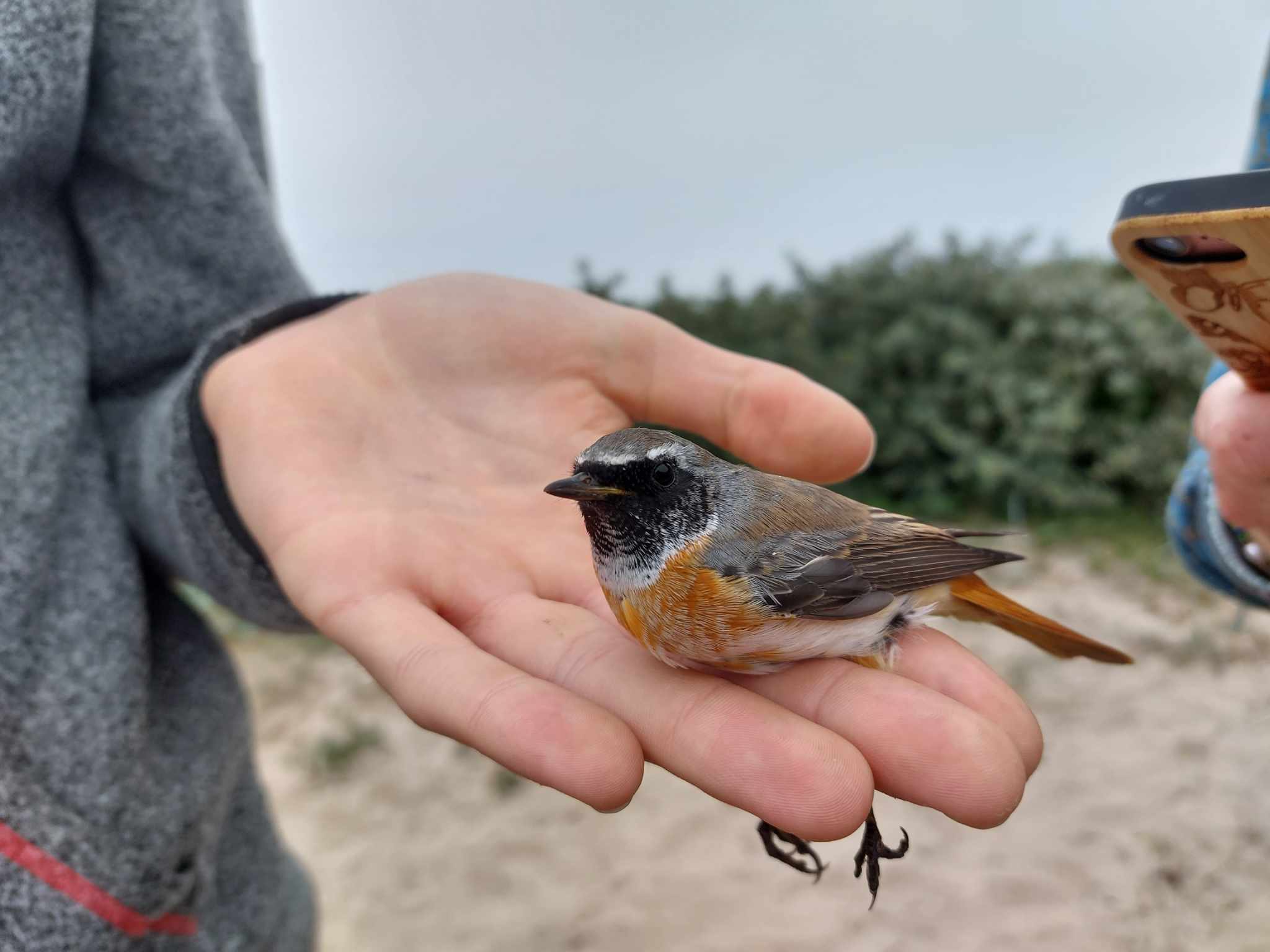


Efter vi var færdige med både ringmærkningen og observation tog jeg med Hayley til Skarvtælling ved havnen. De har været i gang med at regulere fuglene, men vi lagde ikke mærke til nogle nye tendenser ved flokken denne gang.
Simon tog igen ud til Grenen, hvor han så Dværgfalk, Rød Glente og Skærpiber.


 Rødstrubet Lom - Simon Kiesé
Rødstrubet Lom - Simon Kiesé
Ringing (Kabeltromlen):
Dompap - 1
Løvsanger - 1
Gransanger - 1
Rødstjert - 1
Grønsisken - 1
Rørsanger - 1
Kærsanger - 1
Rødhals - 4
Munk - 11
Total: 22
Ringing (Jennes Sø):
Gærdesmutte - 1
Jernspurv - 1
Gærdesanger - 1
Munk - 2
Gransanger - 6
Topmejse - 1
Musvit - 3
Lille Gråsisken - 5
Total: 20
People: Antonia Greil, Hayley Land, Rebecca Cheape, Gustav Nyberg, Simon Kiesé, Henning.
A link to today's observations from volunteers and local observers.
Jay and Joy
Maybe getting up early for the last time this year is a ray of hope. Nevertheless, too early for the inner clock, we set off for ringing at Skarvsøn and opened the nets. Since Simon was away ringing, we were joined by Henning, a ringer from the south of Denmark. Our guests did not miss the opportunity to watch the scientific bird ringing on their last day here. The wind of the last days had almost completely disappeared and for the first time in a week we had the impression that it could be a really good day.
The nets are opened and we set off for the first round. I walk in front and a Water Rail (Vandrikse) flies up in front of the first net. Oha, Water Rail! But it turns away and flies parallel to the net. Shit, we don't get it. Then it turns just before the end of the net and bang - we've got it. Quickly, very quickly, I sprint to stop it from flying away out of the net, which is too fine-meshed for such large birds. What a take-off. The especially cool thing was that it was even a magnificent adult bird.
 even steel rings worked well, because Simon the first had shown us before how to do them
even steel rings worked well, because Simon the first had shown us before how to do them

There were also some Reed Warblers (Rørsamger). Then suddenly we heard squawking cries from the net and we had caught the second big bird. A Jay (Skovskade)! How awesome. This one pleased me personally even a little more, as I had never held the species before.

The ringing went well without Simon the first and I now have a good pace in ringing (which was required because we had quite a lot of birds in the round) with consistently good quality. I think it's really cool how much I've learned in the last month and a half here. I also want to give this compliment to all the other volunteers here. Together as a team we have managed everything well, helped each other and discussed interesting features together. Just the way it's supposed to be. Other cool catches were Sedge Warbler (Sivsanger) and an early Brambling (Kvækerfinke). The first Rock Pipit (Skærpiber) of the autumn flew over and some Meadow Pipit (Engpieber) and Yellow Wagtail (Gul Vipstjert) flew around. We also saw a Shoveler (Skeand) and a Little Grebe (Lille Lappedykker). What a nice day!
Meanwhile, the migration count was also a bit better than the last few days. We are still waiting for the next big surprise, but we were able to observe some eastbound Black Scoters (Sortand) from World's End 3. Okay, it’s the same as every other day (that’s Gustav’s quote). But I’m sure that will change soon. There will be some good birds soon, definitely! As the ringing team took down the nets at Skarvsøn afterwards (CES season is over), Gustav was home early and kindly tidied up and cleaned the flat. I think it's really great how everyone helps out and contributes to everyone having a really great time here.

Ringing (Skarvsøn):
Jay (Skovstade) - 1
Water Rail (Vandrikse) - 1
Chiffchaff (Gransanger) - 5
Reed Warbler (Rørsanger) - 9
Marsh Warbler (Kærsanger) - 3
Sedge Warbler (Sivsanger) - 1
Blackcap (Munk) - 8
Reed Bunting (Rørspurv) - 1
Chaffinch (Bogfinke) - 1
Brambling (Kvækerfinke) - 1
Total: 31
Ringing (Jennesø (Michael)):
Wren (Gærdesmute) - 2
Robin (Rødhals) - 1
Blackcap (Munk) - 2
Chiffchaff (Gransanger) - 3
Willow Warbler (Løvsanger) - 2
Great Tit (Musvit) - 4
Lesser Redpoll (Lille Gråsisken) - 3
Total: ?
People: Antonia Greil, Hayley Land, Rebecca Cheape, Gustav Nyberg, Simon Kiesé, Ole and Birgitte, Henning.
A Link to Today's Observations From Volunteers and Local Observer's
